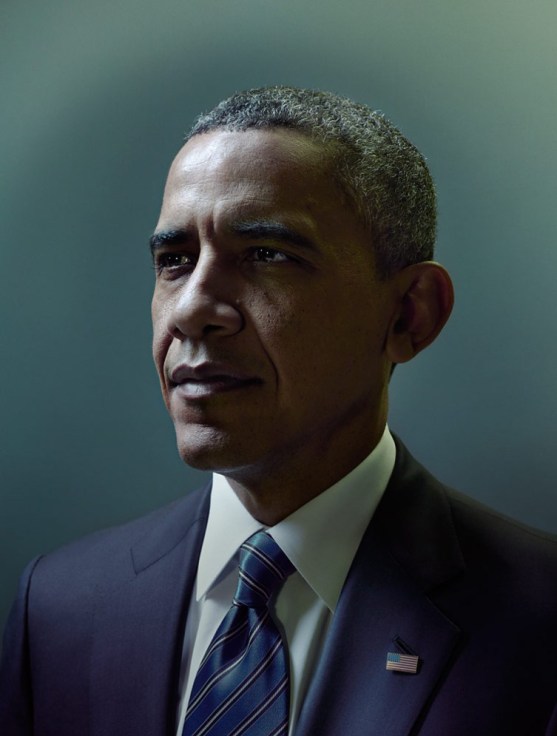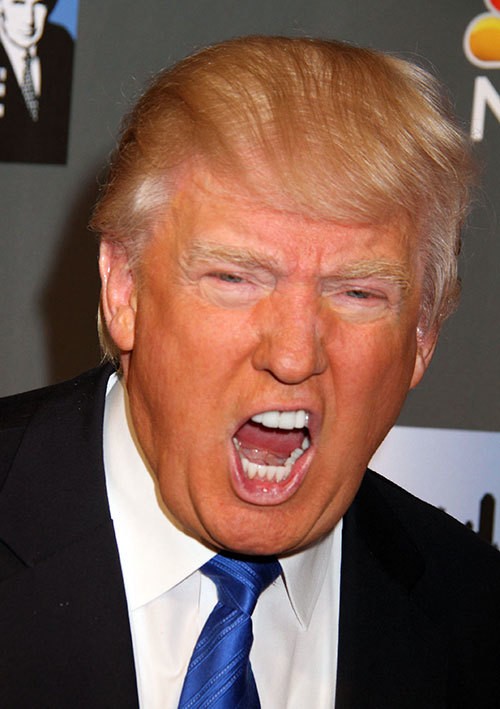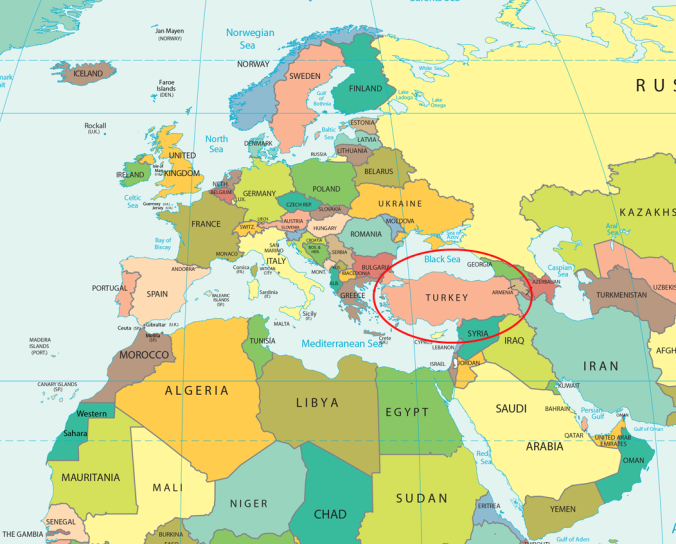
Europe on one side, Asia on the other, with Russia and Africa relatively nearby. Image source: Want to Know It?
Turkey has been in the news a lot recently, and mostly not for very good reasons. It’s a pivotal country with a big population and a strategic location, but it’s also going through profound changes, so the amount of coverage is understandable. Although Turkey tends to stay aloof from its Arab and Persian neighbors, understanding Turkey is key to understanding the intricate dynamics of West Asia, and that’s what this blog post will try to help with — as much as a single post can explain a country as deep as Turkey, anyway.
HISTORICAL BACKGROUND
Although it’s not considered one of the ancient “centers of civilization” like Mesopotamia (Iraq) and China, Turkey ranks right up there in terms of how ancient its history is — the recent excavations at Göbekli Tepe reveal complex societies there 11,000 years ago. It was important in the ancient Greek and Roman eras and later became the center of the Byzantine Empire, the Greek successor to the Roman Empire in the east. However, this isn’t very relevant today, so fascinating as it is, I’ll skip it.
Modern Turks prefer to trace their history back to the Osmanlis (or “Ottomans”), a dynasty that took power in the 1300s. Their roots are in Central Asia, a huge region generally called “Turkestan” in the past and with a plethora of Turkish peoples (now called “Turkic” to distinguish them from the Turks in Turkey). The Byzantine Empire had already been pushed back by a Turkish people called the Seljuks; the Osmanlis wiped it out entirely and created a great empire stretching from the Balkans to North Africa and Arabia. In the 1500s it was one of the most powerful countries in the world and threatened to conquer Europe’s heartland. It held its own against Iran, then ruled by the powerful Safavid Empire. Its sultan declared himself caliph, or ruler of all Muslims, at least in a spiritual sense. Its capital, Istanbul, strategically situated on the narrow straits that separate Europe from Asia, became one of Islam’s most important cities and a melting pot of the various peoples of the Osmanli Empire (Greeks, Turks, Arabs, Albanians, Serbs, Kurds, Armenians, Bulgarians, Jews…).
But like all great empires, the Osmanli regime fell into decline. It was a slow, mostly imperceptible process, but mostly it just didn’t keep up with the changes happening elsewhere in Europe. North Africa became independent in all but name; Arabians away from the coast just ignored it; even rule over Arabs in the Levant and Mesopotamia (modern-day Syria, Iraq, Lebanon, Israel and Jordan) was mostly indirect. By the 1800s it was derided as the “sick man of Europe” and became tempting prey for Europe’s increasingly predatory empires. Their unending rivalries and paranoia prevented them from actually carving it up, but the new forces of nationalism helped fragment it anyway as Balkan countries started breaking off. An internal reform movement shifted power away from the sultan and toward bureaucrats, the military and eventually (1908) a legislature, but the decline continued.
The empire was finally shattered in World War I, when it sided with the Central Powers (Germany and Austria-Hungary) and found itself under attack from all sides. Stirred up by the British, the Arabs revolted and started their own countries. Much of the Armenian population was wiped out in a death-march to Syria to keep them from aiding the Russians, who seized northeast Turkey. By the war’s end, the empire had been whittled down to Turkey itself, or the peninsula once called Anatolia. It faced a punitive peace treaty afterward, with a big indemnity, zones of foreign occupation, and territorial losses to Greece, a new Armenian country, and maybe even Kurdistan. But — unique among the Central Powers — Turkey fought back under a new government led by disgruntled officers in a sort of regional sequel to World War I. A Greek invasion was repulsed, ethnic cleansing made Turkey more homogeneously Turkish (and Greece and Bulgaria less so), and the independent Armenia and Kurdistan and foreign occupation never happened (except for a short time around Istanbul).
The mastermind of this comeback, Mustafa Kemala, then set about creating a new Turkey. The old Osmanli Empire and its sultan were abolished (and the caliphate with it). The new Turkey would be much more European in its outlook, so the deep Islamic influences on Turkish culture were minimized: religious orders and schools were abolished, women were discouraged from wearing veils, men were banned from wearing fezzes (themselves an 1800s sign of modernization). Public displays of piety in general were curbed. Turkey was reorganized as a republic with Kemal as a dictator. The Western calendar and metric system were introduced. Thanks to the loss of its old empire and the recent ethnic cleansing, Turkey also became much more nationalist. Turkish was purged of as many Arabic words as possible, which were replaced by European loanwords or newly invented Turkish words. Arabic script was replaced by the Roman alphabet. Mass education helped spread these reforms to the new generation, along with barmy ideas about how Turks were the creators of civilization. A command economy along Soviet lines kept the country under the tight control of Kemal, who became known as “Atatürk,” or “Father of the Turks.” He is still revered in Turkey today and did more than anyone else to bring Turkey into the modern world.
Turkey’s history since then has mostly steered a middle path. It aligned with the Western camp in the Cold War, but stayed neutral in World War II. It continued to develop and modernize, but not as much as, say, Japan. It was roiled by political turmoil and dictatorship, but not as much as its unfortunate Asian neighbors. Atatürk’s dictatorship loosened by the mid-1900s as more Turks were drawn into the political process and populist leaders like Adnan Menderes and Süleyman Demirel opened up the economy and improved national infrastructure. Still, Atatürk had left Turkey a “deep state” — a cadre of bureaucrats and officers loyal to his original vision of a secular, authoritarian, Western-oriented country that remained in place throughout election cycles — and it fought back occasionally, although military rule would only last a few years and focused on paving the way for a more “responsible” successor. There was also an ongoing rift between Turkey’s rural, conservative hinterland and its more modern, liberal cities, especially in the west closer to Europe — although this rift also played out in Istanbul, which grew even bigger thanks to increased migration to its booming industries.
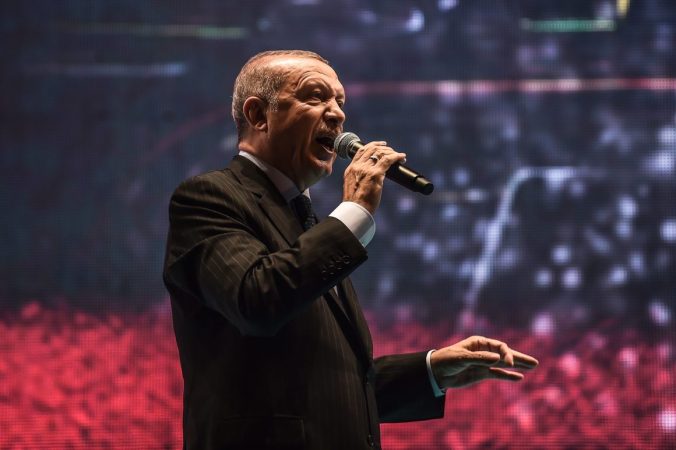
Image source: Ozan Kose/AFP via Getty Images
THE ERDOĞAN ERA
By 2000, Turkey seemed like it had turned a corner and left its sometimes turbulent recent past behind. The economy was growing at a fairly steady clip (3-7% a year), although it crashed in 2001; Turkey joined the G-20, an expanded version of the G-8 that includes the most important emerging economies. Turkey had joined a bunch of pan-European organizations (NATO, the Union of European Football Associations, Eurovision), and Turks had steadily migrated into Europe as manual laborers. It was more and more accepted as part of Europe, and the intellectual class had firmly aligned itself with European mores. The president elected in 2003, Recep Tayyip Erdoğan (seen above), encouraged greater public expression of religiosity (veils, hijabs, Islamic schools, public prayer, mosques) while maintaining Turkey’s overall secular orientation and disdaining the fanaticism that gripped other Muslim societies. This form of political Islam (“Islamism”) was welcomed by Westerners nervous at the breakdown of society in many Muslim countries and the apparent dead ends in the Muslim world’s development. By 2005, Turkey was in talks to enter the EU, which would formally crown it as a member of the European community.
Yet Turkey didn’t end up traveling the track of European integration. The EU talks never went anywhere. The logistics of joining the EU were never really grappled with — with a population of 80 million, Turkey has about as many people as Germany and would be in a position to dominate the EU (or at least its parliament). That would be a “problem” because Europeans have never really wholeheartedly embraced Turkey as one of their own, either because of a long historical antagonism or Islamophobia — or just a sense that Turks are not really culturally European. In any case, Turks noticed this, and their relationship with Europe noticeably soured.
Meanwhile, Erdoğan began showing noticeable authoritarian traits. He is infamous for his short temper and lashes out at any critics. This meant going after journalists with unflattering stories or opposition politicians. He would explode in rage at stuff online that ran counter to his own views and take Facebook, Twitter, WhatsApp and YouTube down (in Turkey) for posting things that portrayed him in an unfavorable light. He also built a lavish, expensive palace for himself, complete with guards in medieval armor. In 2013, simmering popular discontent in Istanbul, especially among the youth, erupted in protests over plans to build over a park there. While it may have been a trivial local issue, the protests were energized by a sense that Erdoğan acted in a high-handed manner without concerns for his opponents — a sense that was vindicated when police used tear gas, water cannons and batons to break them up.
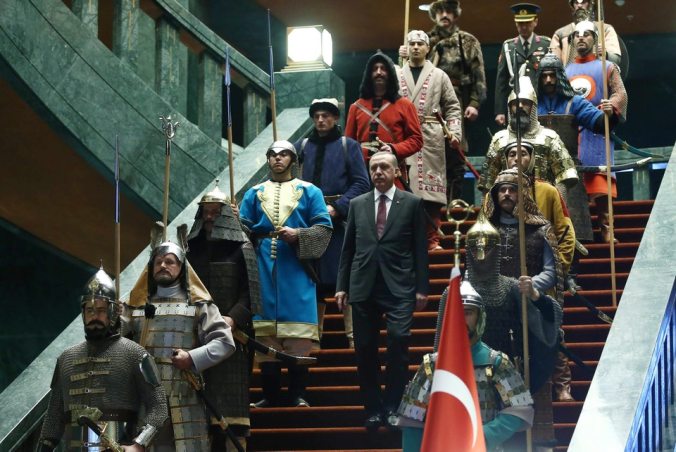
Image source: Reddit
These issues caused a good deal of concern abroad, but the turning point really came in 2016, when a disgruntled faction of the military attempted a coup. For a night the world watched anxiously as protesters attacked tanks in the streets of Ankara, the capital, warplanes zoomed overhead, and Erdoğan’s whereabouts were unclear. But Erdoğan still had popular support on his side, and the coup failed. The deep state has apparently been vanquished. To make sure, Erdoğan initiated a wide-ranging purge of Turkish society, getting rid of 170,000 bureaucrats, judges, lawyers, police, soldiers and teachers with suspect loyalties, especially if they were affiliated in some way with the man he blames for the coup, Fethullah Gülen. They were replaced by loyalists and members of his party, Justice and Development (AKP), irrespective of talent or qualifications.
Erdoğan cemented his dictatorship with a constitutional referendum last year that granted him broader presidential powers like rule by decree and increased appointment authority (he switched to the presidency in 2014). The vote was marred by fraud and the two sides didn’t have a level playing field. The courts are compliant and the media has been intimidated into submission (hostile news stories land their writers in jail and their outlets huge fines). While there are still opposition parties in parliament and they made a strong showing in this year’s election, it seems fair to say that Erdoğan’s power is secure and he no longer faces credible pushback. Throughout, he has maintained strong support among the Turkish populace, who admire his piety, working-class background, blunt, no-nonsense style and infrastructure projects. Though by no means the only example, he has become the poster-child for a new breed of dictator in the ’10s that works from a democratic basis to carefully and gradually gut the opposition and consolidate far-reaching control for themselves.
Like many dictators, Erdoğan also relies on nationalism to shore up support. Turks are proud of their imperial past and look back fondly on the Osmanli days (one of the plans for that Istanbul park is to rebuild the Osmanli barracks that once stood there). Erdoğan once claimed that Turks somehow discovered America. A constitutional article makes it a crime to insult “the Turkish nation.” Warm relationships with the Turkic countries of Central Asia have been cultivated after their 1991 independence. However, Turkey is still a multi-ethnic country, so this rhetoric causes friction with minorities. The Armenian Genocide is denied, and anyone who discusses it is attacked ferociously (in the case of Hrant Dink, an Armenian journalist, even assassination). Relations with the Kurds in the southeast have always been testy, since they are widely suspected of craving independence and generally resist attempts at integration. In recent decades, this testiness has periodically exploded into insurgency; since 2015, we are currently in one of these phases.
All of this has strained Turkey’s relations with Europe. Always somewhat uncomfortable with it, Europeans have now become outright hostile. Erdoğan has returned the favor by slamming the Netherlands and Germany as “Nazi” for preventing him from campaigning there during the 2017 referendum campaign. Like many other peoples, Turks increasingly view Europeans as sanctimonious, condescending and snooty, and even charge that democracy and human rights rhetoric are used as a cloak to justify excluding Muslims. Relations with Greece, Turkey’s historic enemy, remain frosty despite numerous cultural ties. Nevertheless, Turkey is still seen as a crucial bulwark against more threatening forces further east; these days, Europeans are terrified of Syrian refugees, and Turkey has taken in millions of them so Europe won’t have to — something European leaders are very grateful for.
Given that it borders Syria, the vicious war there has dominated Turkish foreign policy this decade. In general, relations weren’t good before the war; now Turkey is actively involved in trying to unseat Syria’s dictator, Bashar al-Assad. Turkey plays host to NATO forces from its air base at Incirlik and the governing councils of Syria’s opposition forces. It is a crucial combatant in the war against the Islamic State. But NATO is also increasingly frustrated with Turkey because the latter cares way more about Kurds than the wider war. Syria’s small Kurdish community has borne the brunt of the fighting against the Islamic State and has created a quasi-state, Rojava, along the Turkish border. This could be the nucleus of a future Kurdistan encompassing southeast Turkey, so Turkey intervened earlier this year to create a buffer zone on its border to keep the Kurds apart. This has brought it into alignment with Russia (even though Russia supports Syria), and Turkey bought an advanced Russian anti-aircraft system last year. A full-blown alliance remains a distant prospect given their conflicting desires for Syria, but Turkey clearly no longer sees NATO as an appealing alliance.
This has naturally also led to strained ties with America. Throughout the war with the Islamic State, America has been begging Turkey to devote more resources to the jihadists and less to the Kurds, who were instrumental in IS’s defeat. A group of Erdoğan’s bodyguards beat up protesters when he visited Washington, D.C. Turks have long bought into conspiracy theories about the CIA’s intentions in Turkey and West Asia, and many are suspicious about its possible involvement in the 2016 coup attempt. Turkey has demanded America extradite Gülen, who lives on a rural estate there; America has refused. The latest imbroglio involves an American pastor, Andrew Brunson, whom Turkey has jailed as part of the post-coup purge. Turkish obstinacy over his detention led America to slap it with steel and aluminum tariffs. This has exacerbated a currency crisis going on throughout the year caused by Turkey’s high foreign debt and a strengthening dollar. Further exacerbating it is the Turkish government, which has become a financially illiterate clique dedicated to sucking up to Erdoğan (who refuses to raise interest rates because he thinks that would worsen inflation). It is a slow-moving crisis that hasn’t spread beyond Turkey much yet, but it has revealed how hollow the Erdoğan boom really was and scared most foreign investors away from Turkey.
In many ways, Turkey has similarities with Russia. Both are countries on the fringes of Europe with an ambivalent relationship with it — at times yearning to be a part of it, at others scoffing at it and emphasizing their distinctiveness and independence. Both look back on past days of glory and power fondly and yearn to relive them somehow. And both are examples of countries that traveled down the liberal democratic track before veering off course. Russia has done so more dramatically than Turkey, but Turkey’s recent example as a vibrant, proudly Muslim democracy with close ties to Europe and high living standards unrelated to oil wealth made its transformation especially painful for Westerners. Its future course remains uncertain — is it still interested in joining the EU, or does it see its future with Russia, Iran, the Persian Gulf and China? Will it ever resolve its old animosities with the Armenians, Greeks and Kurds? Will Erdoğan’s new dictatorship endure, or will the youthful discontent on display in 2013 erupt into something more akin to the Arab Spring? The answers to these questions are beyond the scope of this post, but suffice it to say that Turkey will engage the attentions of the world for many years to come as it combines unpredictability with strategic vitality.
